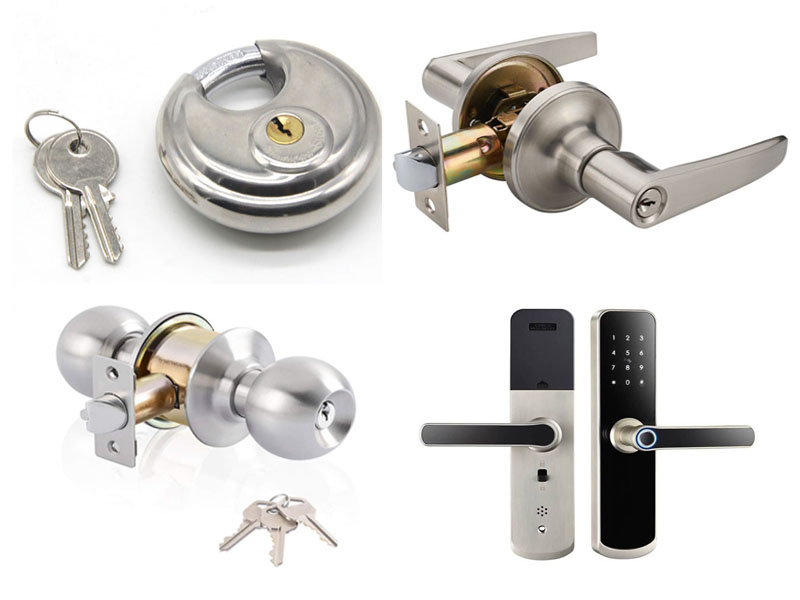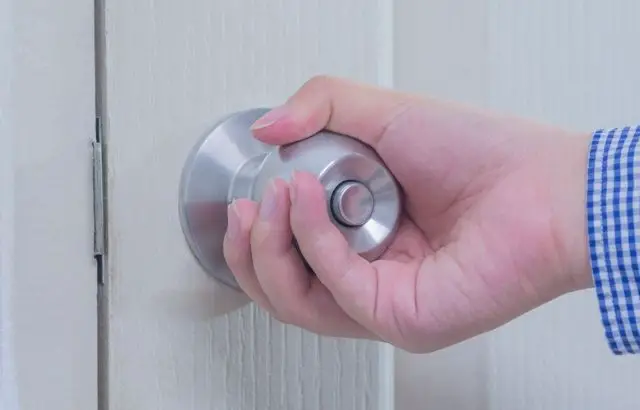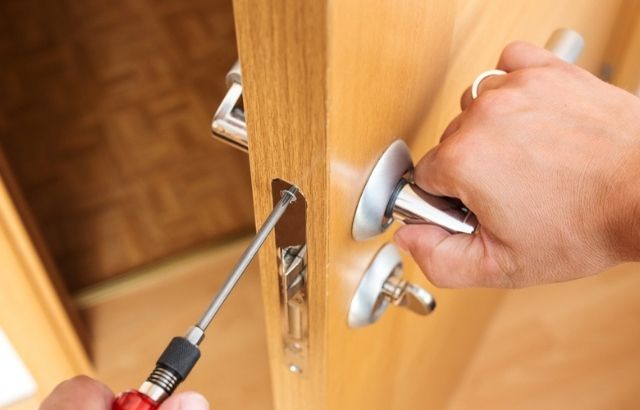Well! I can imagine how annoying it can be to stay in a locked bathroom for several hours. Luckily, most bathroom doors have privacy doorknobs in the US instead of security locks that act as a standard tool in your homes. That means you will not have to face concern in the case of an emergency. When you are suffering from such a situation, you always decide to call the locksmith. However, it is possible to discover how to unlock a push and twist button lock with some effort and some essential tools, especially when there is someone outside to help you to open a locked door.
Learn More: How To Fix A Door Lock
How To Unlock Push And Twist Button Door Lock
There are a few simple and easy tricks to open a locked bathroom or bedroom door without a key:
Follow this 13 steps to unlock a door with push and twist button lock.
- Credit card
- Substitute key or a screwdriver
- A Paper clip and a tension wrench
- A metallic coat hanger
- Pick the lock
- Pin by pin method
- Scrubbing method
- Unlock the lock with a butter knife
- Open the push-button lock with the foot
- Use the cord to unlock the door
- Remove the hinges
- Unlock the door lock by removing the door handle
- Open the door with the hammer
Credit card
You can open lever-type doorknobs, spring locks, and latch bolt knobs with the credit card very quickly, but it does not work for the deadbolt locks. But remember to choose the right type of card. The best cards to open locked doors are stiff, laminated, or flat and flexible ones; do not use your identification card, debit card, or credit card to save it from damage.
The procedure involves slipping the card between the lock and the door frame, bending it back, and pushing the bolt from inside.
Learn More: How To Install Pocket Door Lock
Substitute key or a screwdriver
One of the practical and quickest ways to open a locked door is to use a spam key, but you can opt for another alternative to get out of the situation if you don’t have it.
If your door has a privacy handle, you can use a screwdriver to unlock the door. Remember that you should turn the handle while opening it. There is a tiny hole on the side of the door handle; put a flat head screwdriver into the lock as far as you can. You can’t put the tools with thick ends into the key lock, so you should be careful while doing. Turning and wiggling the device will catch the grooves very quickly. When you hear the sound of a click, it means that you finished the job successfully.
A Paper clip and a tension wrench
In an exigency, a hard paperclip is an excellent item to use to open the locked bedroom door. If you have two paper clips, the method will be simple; you only need to bend the first one and fold out the second one to straighten it as much as you can. Place the straight paperclip below the bent one as you now put it inside the lock’s keyhole. Once the door is unlocked, move the second piece around it.
A tension wrench is like a minor hex key, available at any hardware store, which is best to create tension inside the lock. You should insert the wrench in the bottom of the lock and rotate to make the tension on the lock. When you wiggle the paperclip inside the lock at the top, you will hear the sound of a click, and the door will open.
A metallic coat hanger
A latch bolt in the bathroom or bedroom doors, dragging the bolt with a metallic coat hanger, is an excellent tool to open a locked door.
It is essential to bend your hanger to give the shape of a handle and the hook at the other end. Now place the clip between the edge of the door and the wall. Now fold it around the latch bolt. Then twist the knob with the other hand while dragging the hanger towards your direction. Remember that this technique will work if you don’t have a gap between the door and the wall.
Pick the lock
The procedure will become complicated if you don’t have instructions in your hand. To do this job, you should opt for an Allen wrench and place its shorter end on the lower edge of the lock’s keyhole. Keep the constant pressure and twist the lock slightly.
There are two fundamental procedures to complete the job successfully.
Pin by pin method
Push the paperclip slowly when you exert pressure on the Allen wrench. Catch and bend the paperclip, and lift it upward until you hear the sound of a click.
Scrubbing method
Gently push the Allen wrench at the keyhole and lift it upward to make circular motions.
Unlock the lock with a butter knife
You may not believe that a butter knife can be a great instrument to work with if you have a push-button lock. Only you have to place it in the keyhole and turn it to open the lock. It is better that you should not use sharp knives to prevent cuts in your hands.
Open the push-button lock with the foot.
If you don’t have tools and are strong enough, you can do the task by combining Newton’s third law of motion and SWAT Style kick to unlock the bathroom door. If the door has a weak lock mechanism and the door opens in an outward direction, the procedure will work. It will not be a complicated procedure at all, and you only have to kick the door with your dominant leg at the weakest point of the doorknob. Repeat the process with the flat foot if you fail at the first attempt.
Use the cord to unlock the door.
One of the easiest ways to open the locked door is to use a cord with a slipknot or a thick rope without damaging it. It would help if you had a small window at the top of your door to do this action. The cord should be long enough for picking a lock placed on the outside. Use the rope or a line to hold the lock and then tug from both sides to unlock the door.
Remove the hinges
It is a successful and a bit aggressive method to unlock the door. For this process, you have to take a flathead screwdriver to place it between the bottom of the door knuckle and the pin. Push the screwdriver downward with the hammer until the head and the pin leaves in place. When you remove all the hinges of the door, you can unlock the door.
Unlock the door lock by removing the door handle
If you are unsuccessful in unlocking the door with any other method, you can go for this method. Loose the exterior screws of the door handle with the screwdriver as a lever. Please put it in the lock’s keyhole and twist it gently until you hear a clicking sound.
Open the door with the hammer.
Unlocking the door with the hammer will be the last way, as it can damage your door ultimately. You should hit the bathroom or bedroom door with the hammer and break the lock and detach it from the door.
Types of Door Lock

You can find several types of Door locks:
Padlocks.
Padlocks are available in numerous sizes and are interchangeable. Keyed and combination padlocks are the two most common types, and both are easily identifiable. To open a combination padlock, its owner must know the correct sequence of digits to enter. These clasps are simple to manipulate or decipher.
Deadbolts.
In contrast to padlocks, people use deadbolts on exterior doors and you can adjust them in various ways. There are single, double, and lockable thumb-turn options available. The lock’s exterior features a key barrel for the single cylinder, whereas the interior features a thumb-turn. With access to the thumb-turn, an intruder can easily unlock the lock from the inside.
Lever Handle Locks.
On the interior doors of commercial structures, lever locks are common. These locks are considerably easier to open than knob locks. A large push-down handle is performs to unlock the door. This lock is ideal for improving access for the disabled. Torque attacks can cause lever locks to fail under pressure.
Knob Locks.
Typically, these locks are installed on the exterior doors of homes. In conjunction with deadbolt locks, they add a layer of security to the door. A knob lock is insufficient to secure an exterior door. This is because the cylinder is located on the doorknob instead of the door itself.
Cam Locks.
Typically, these locks perform to secure a filing cabinet or mailbox. They are available in various sizes and compatible with other locking systems. To unlock the lock, turn it either clockwise or counterclockwise.
Euro Profile Cylinders.
These locks are a popular option for European glass sliding doors and partitions. There are a variety of variations available for purchase. The external length of the lock may differ between manufacturers, but its dimensions will remain constant.
Mortise Locks.
Mortise locks or rim locks, are common on commercial and glass doors. Rim cylinders and rim latch locks are compatible. The door latches are situated within the door. It has a long metal bar on the back that keeps the door securely closed when engaged with the lock mechanism of the opposite door. Two screws secure the lock’s cylinder at its end.
Wall Mounted Locks.
These wall-mounted locks are standard equipment in the majority of large commercial structures. They protect the contents within. They function well as both standard door locks and emergency exit locks in areas where people store the building keys.
Vending locks
These locks are also the T-handle locks ones. Typically, you can find them in vending machines. They remain valuable in various situations, and exchanging them is straightforward. Once the T-lock has been unlocked, it can be removed and replaced. There are two types of latches: spring and dead.
You can find these locks on tables, cabinets, and sliding doors and is available in two styles. A flat metal extension attached to the side of the bolt increases its security. A rod holds the lock securely on the model with a button.
Rim Latch Locks
One side features a rim cylinder, while the other features a surface mount cylinder. It is reassuring to know that these protect the door you just closed. They are commonly found in homes and can be combined with other locks to enhance security.
Pros & Cons of Using Push and Twist Button Door Lock
| Pros | Cons |
| Pushbutton locks are popular among building owners and managers because they allow for centralized management. | With keyless entry, you can give your access code to whoever you want, whenever you want. As a result, keeping track of who enters and exits a building becomes more challenging. |
| At best, tracking who has a key and how many have been made is difficult. Another possibility is that an employee illegally duplicated the key. | Hardware and software can fail, like any other technological system. The security of battery-powered locks is only as strong as their power source. Be sure to replace your batteries regularly. |
| A pushbutton entry system is more durable because it eliminates the repetitive motion of turning a key. We expect the pushbuttons to last significantly longer than the keys. | A pushbutton entry system is more expensive to install. Because the technology is superior to standard locks, the upfront cost is higher. |
| When it comes to pushbutton technology, numerous designs and styles are available. They are made from durable materials and offer protection against criminals and the elements. | In addition, it may require more maintenance in the future as technology develops. |
Why Use Push and Twist Button Door Lock
The majority of people associate keyless entry with convenience. In contrast, keyless entry is more than convenience or not having to fumble with keys. Most electronic door locks, including keypads, are easy to install and maintain, and some models even permit retrofitting, allowing you to upgrade from a conventional mechanical door with minimal downtime.
Access control systems that can adapt to the needs of the building’s occupants are critical in more security-conscious environments or companies with a high turnover rate. In this context, keyless entry is frequently a game-changer. A password can prevent the loss, theft, or duplication of mechanical keys (so long as it is well-chosen and periodically changed).
Employers and security personnel face unique obstacles due to the high turnover, long hours, and expansive layout. Physical keys necessitate considerable management and organization, which consume time and resources that you could better utilize elsewhere.
As technology advances, keyless entry system aesthetics evolve. Electronic door locks are available in different weather- and tamper-resistant, aesthetically pleasing packages.
The efficiency of locks is proportional to the level of protection they offer. This holds for both mechanical and electronic locks.
Most of these locks are similar to latches, mortises, and deadbolts, with dead latches and exit devices. The best way to ensure you receive the optimal features and protections for your situation is to consult a professional.
Things to keep in mind to Unlock Push and Twist Button Door Lock
Identifying problems with door locks caused by defective door locks is straightforward. You will likely discover a problem when you attempt to use your lock. Extremely annoying, both the interior and exterior of the lock are prone to becoming loose. Over time, the screws that hold the lock’s components together may become loose, worn, or broken.
Locks and strike plates with improper alignment are frequently used interchangeably. As a result, they frequently cause the same door lock problems.
Locks and strike plates that are out of alignment are easy to spot. As its name suggests, this lock is one in which critical components of the locking mechanism don’t have a proper alignment to facilitate the door’s essential functions.
You are fortunate if you have never experienced this. Because a broken key in a lock affects other factors that you must now consider, this problem becomes difficult to solve.
Different factors can cause a jammed lock. So, a common cause of a jammed door lock is the accumulation of dust and dirt, which can slow the internal mechanisms.
Moreover, if the door latch or lock bolt is broken, the lock will become jammed. Although the origins of these lock issues vary, the consequences are frequently the same. Each one renders the door’s lock inoperable by hammering it.
Frequently Asked Questions
How do you unlock a push-lock door?
You can unlock a push door lock with the screwdriver, as a small and thin screwdriver can work best on interior doors with privacy handles. You have to insert the screwdriver in the keyhole in the knob door straight as far as you can. Then twist the screwdriver till the lock opens.
How do you unlock a push and twist door lock without the hole?
Grab the doorknob in your non-dominant hand. Hold it in your left hand if you are right-handed. Make the gap between the door frame and the locked door as wide as you can by pushing the door. Now place the plastic card in the opening of the doorknob; this will make the door open.
How do you open a twist-lock from the outside?
Insert the wire into the hole located in the center of the hole of the doorknob. Now the tip of the hanger or a piece of paper clips into the hole and keep it as straight as possible.
Expert Opinion
If you have a common problem with your bathroom doors regarding locks, you should have the lock picking set in your homes for must. It will then be an easy task to unlock your locked doors without any worry and extra tools. Hope you have learned how to unlock the push and twist button door lock.




